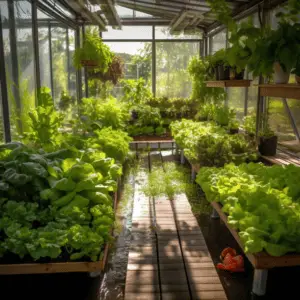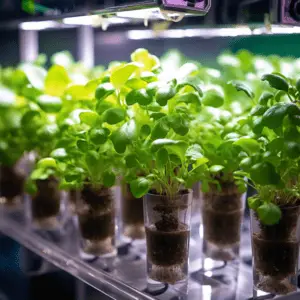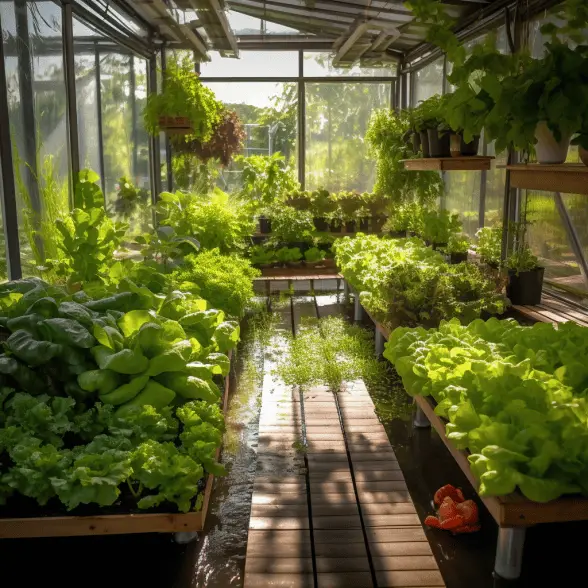
Are you new to hydroponics, or have you been growing for a while but struggling to achieve optimal results?
There are several common mistakes that many growers make when starting out with hydroponic gardening, but with the right knowledge and techniques, these issues can easily be avoided.
One of the most important aspects of hydroponic gardening is understanding how to maintain a proper balance between all of the elements necessary for plant growth.
From selecting the right system to monitoring pH levels and providing adequate lighting and nutrients, there are several key factors that can impact your success as a hydroponic gardener.
In this article, we’ll explore some of the most common mistakes made by novice and experienced growers alike, along with tips on how to avoid them.
By following these guidelines, you can ensure that your plants thrive in a healthy and productive environment.
KEY TAKEAWAY
What are the common hydroponic mistakes to avoid?
Hydroponics is an efficient way of growing plants, but it requires proper management to avoid common mistakes that can damage plant growth and health.
Overfeeding plants, ignoring pH levels and water quality, inadequate lighting, crowding plants, and failure to maintain equipment can all lead to issues.
Plant health and growth can be maximized by ensuring the right balance of nutrients, pH levels, and lighting, along with proper plant spacing and equipment maintenance.
Choosing the Wrong System for Your Needs
Don’t make the mistake of picking a hydroponic system that doesn’t fit your specific requirements. (1)
There are many different types of hydroponic systems available, each with its own set of advantages and disadvantages.
Some systems are better suited for small-scale operations, while others are designed for larger commercial setups.
It’s important to do your research and choose a system that will meet your needs.
One common mistake is choosing a system that is too complicated or difficult to maintain.
While some advanced systems may offer more control over growing conditions, they can also be more challenging to operate and require more maintenance.
If you’re new to hydroponics, it’s best to start with a simple system that is easy to use and maintain.
Another mistake is choosing a system that doesn’t match the plants you want to grow.
Different plants have different nutrient requirements and grow at different rates, so it’s important to choose a system that can provide the right nutrients and support for your chosen crops.
Be sure to consider factors like lighting, temperature, humidity, and airflow when selecting a hydroponic system for your plants.
Not monitoring pH and nutrient levels can lead to plant stress or even death if left unchecked.
In order for plants in hydroponic systems to thrive, they need precise levels of nutrients in their water supply.
pH levels should be monitored regularly as well since fluctuations can affect nutrient uptake by the roots.
By keeping an eye on these factors, you’ll be able to adjust accordingly and ensure healthy growth for your plants in the long run.
Not Monitoring pH and Nutrient Levels

Make sure you keep an eye on the pH and nutrient levels in your hydroponic system to ensure that your plants are getting the right balance of nutrients they need to thrive. (2)
Neglecting this aspect can lead to stunted growth, yellowing leaves, and even death of your plants.
Here are some common mistakes people make when it comes to monitoring pH and nutrient levels:
- Not checking pH regularly: pH is a crucial factor in hydroponics as it affects how well plants absorb nutrients.
If the pH is too high or too low, it can cause nutrient lockout, which means that the plant cannot absorb certain nutrients even if they are present in the solution.
- Overfeeding or underfeeding: It’s important to follow a feeding schedule and measure out nutrients accurately.
Overfeeding can lead to nutrient burn, where excess salts build up in the root zone and damage roots.
Underfeeding can result in deficiencies that affect plant growth and yield.
- Using poor quality water: The quality of water used in hydroponics can affect pH and nutrient levels.
Tap water may contain high levels of chlorine or other chemicals that can harm plants over time.
It’s best to use filtered or distilled water for hydroponic systems.
Monitoring pH and nutrient levels is essential for successful hydroponic gardening.
By avoiding these common mistakes, you’ll be able to provide your plants with optimal growing conditions.
To avoid over or underwatering your plants, it’s important to understand their specific needs based on their stage of growth and environmental factors such as temperature and humidity.
For more troubleshooting guides, check the article out out.
In the next section, we’ll discuss how to properly water your hydroponic garden without causing harm to your plants.
Over or Underwatering Your Plants
Watering your plants in a hydroponic garden can be tricky, as over or underwatering can harm their growth and yield.
While it may seem counterintuitive, overwatering is actually one of the most common mistakes made by novice gardeners.
When you overwater your plants, you risk drowning the roots and limiting their access to oxygen.
This can cause root rot, which will ultimately lead to stunted growth and poor yields.
On the other hand, underwatering can also be detrimental to your plants.
When you don’t water them enough, they become dehydrated and unable to absorb nutrients from the solution.
This can lead to nutrient deficiencies, which will stunt their growth and negatively impact their overall health.
Additionally, when plants are dehydrated, they become more susceptible to pests and diseases.
To avoid both over and underwatering your plants in a hydroponic garden, it’s important to monitor them closely on a daily basis.
Check the moisture level of the growing medium regularly with a moisture meter or by feeling it with your finger up to the second knuckle – if it’s dry at this depth then it’s time for watering.
Remember that different plant varieties have different water requirements; some like moist soil while others prefer drier conditions so research what each crop needs specifically before planting.
As we move onto discussing poor lighting conditions in hydroponic gardening (the next subtopic), keep in mind that proper watering practices are crucial in tandem with providing adequate light sources for optimal plant growth.
Without enough light intensity or duration per day for photosynthesis many crops cannot properly absorb water even if provided adequately!
Poor Lighting Conditions
Without enough light, your plants in a hydroponic garden are like a car without headlights on a dark road – they won’t be able to see where they’re going and will struggle to grow properly.
Poor lighting conditions is one of the most common mistakes that hydroponic gardeners make.
To avoid this mistake, here are some tips that you should keep in mind:
1. Choose the right type of light: Different plants have different lighting needs, so it’s important to choose the right type of light for your crops. LED lights are popular because they consume less energy and produce less heat than other types of lights.
2. Position your lights correctly: Plants need light from all angles, so make sure that your lights are positioned correctly. If you’re using overhead lighting, make sure that it’s not too high or too low for your plants.
3. Monitor the intensity and duration of light: Too much or too little light can harm your plants. Make sure that you monitor the intensity and duration of light regularly to ensure optimal growth.
4. Replace old bulbs: Over time, bulbs lose their intensity and may no longer provide enough light for your plants. Make sure that you replace old bulbs regularly.
Ignoring temperature and humidity control is another common mistake made by hydroponic gardeners who disregard their importance in plant growth and development.
Ignoring Temperature and Humidity Control
If you want to ensure that your hydroponic garden thrives, you need to pay attention to temperature and humidity control.
One of the most common mistakes made by hydroponic growers is ignoring these crucial factors.
Temperature and humidity levels can have a significant impact on plant growth, so it’s essential to monitor them regularly.
The ideal temperature for most plants in a hydroponic system is around 70-75°F (21-24°C).
You must keep the temperature within this range as much as possible because extreme temperatures can be detrimental to plant growth.
If the temperature drops too low or rises too high, it can cause stunted growth or even death of the plants.
Similarly, humidity levels should be kept between 50-60% for optimal plant growth.
To maintain proper temperature and humidity levels in your hydroponic system, you may need to invest in equipment such as heaters, air conditioners, dehumidifiers, or humidifiers.
It’s also important to place your hydroponic setup in an area where there are no drastic changes in temperature or humidity.
For example, avoid placing it near windows where drafts could affect the growing environment.
Ignoring temperature and humidity control is one mistake that can lead to poor results in your hydroponic garden.
However, with careful monitoring and adjustments when necessary, you can create an ideal environment for healthy plant growth.
The next step is ensuring that you’re using high-quality nutrient solutions that provide all the necessary nutrients for thriving plants.
Using Low-Quality Nutrient Solutions
You’ll want to make sure that you’re using high-quality nutrient solutions when growing your plants hydroponically because studies have shown that low-quality nutrients can lead to up to a 40% reduction in plant yield.
While it may be tempting to opt for cheaper options, investing in quality nutrients will save you money in the long run by producing healthier and more abundant crops.
Low-quality nutrients often contain impurities, excessive salts, or imbalanced nutrient ratios that can harm plant growth and development.
These problems may not manifest immediately but can accumulate over time, leading to weak plants, poor root development, and lower yields.
On the other hand, premium nutrient solutions are formulated with optimal concentrations of essential minerals and trace elements that support all stages of plant growth.
They also undergo rigorous testing and quality control measures to ensure consistency and effectiveness.
Moreover, using high-quality nutrient solutions is not enough if you don’t follow the manufacturer’s instructions or adjust them according to your specific system’s needs.
Overfeeding or underfeeding your plants can cause nutrient burn or deficiencies that affect their ability to absorb water and nutrients from the solution.
You should monitor pH levels regularly and adjust them as needed since alkaline or acidic conditions can alter nutrient availability and uptake.
By paying attention to these details and choosing reputable brands of nutrients specifically designed for hydroponics, you’ll give your plants the best chance of thriving in your system.
As we’ve seen, using low-quality nutrient solutions is one of the most common mistakes made by beginners in hydroponic gardening.
However, it’s far from being the only one that could affect your success rate negatively.
Another crucial aspect of maintaining healthy plants is keeping your system clean and well-maintained at all times.
Let’s explore this topic further in our next section on ‘failing to clean and maintain your system.’
Failing to Clean and Maintain Your System
Don’t let your hydroponic system fall into disarray – make sure you’re keeping it clean and well-maintained to avoid hindering your plant’s growth.
One common mistake that many growers make is failing to clean their systems regularly.
If you neglect to clean your hydroponic system, algae and bacteria can accumulate, causing clogs and nutrient imbalances.
This can lead to poor plant growth, root rot, and even the spread of disease.
To prevent these problems from occurring, it’s important to maintain a regular cleaning schedule for your hydroponic system.
This includes cleaning the tank, tubing, pumps, and other equipment on a weekly or bi-weekly basis.
You should also keep an eye out for any signs of algae or bacterial growth and take action immediately if you notice anything unusual.
Another important aspect of maintaining a healthy hydroponic system is ensuring that all components are functioning properly.
Check your pumps regularly to ensure they’re running smoothly and replace any worn-out parts as needed.
Make sure your pH levels are stable by testing them frequently with a reliable pH meter or test kit.
By taking these steps, you can help ensure that your plants have the best possible growing environment.
As vital as it is to keep everything tidy in your hydroponic setup, another mistake growers tend to make is not giving their plants enough space to grow!
In order for plants to thrive in a hydroponic system, they need adequate room for their roots and foliage.
Let’s explore this further in our next section!
Not Giving Your Plants Enough Space to Grow
Your plants are like children and they need room to grow and thrive in your hydroponic system, so make sure you’re not overcrowding them or stunting their potential for growth.
It’s important to have a good understanding of the spacing requirements for each type of plant you intend to grow.
Overcrowding can lead to poor air circulation, increased humidity, and ultimately create an environment that is conducive to pests and disease.
To avoid this mistake, start by researching the specific needs of your plants and what kind of space they require.
Consider how much vertical space they need as well as how much horizontal space they will take up once mature.
Make sure each plant has adequate access to light sources, nutrients, and water.
If necessary, invest in larger containers or adjust the layout of your system accordingly.
Another way to ensure your plants have enough space is by practicing pruning techniques.
By regularly removing dead or dying foliage and cutting back overgrown areas, you can help maintain healthy growth patterns while maximizing available space.
This will not only prevent overcrowding but also promote better yields and healthier plants overall.
Remember that with hydroponics systems, good planning is key – give your plants the right amount of space from the start for optimal results!
Conclusion
Congratulations, you’ve just learned about the most common hydroponic mistakes and how to avoid them.
By now, you must know that choosing the wrong system for your needs could lead to disastrous results.
Similarly, not monitoring pH and nutrient levels or over/under-watering your plants can be detrimental to their growth.
Poor lighting conditions, ignoring temperature and humidity control, using low-quality nutrient solutions are other hazards that can ruin your hydroponic garden.
However, by following these guidelines and being mindful of these pitfalls, you can enjoy a thriving indoor garden all year round.
Remember that cleanliness is paramount for maintaining a healthy hydroponic system.
Keep an eye on your plants as they grow and ensure that they have enough space to develop fully.
With proper care and attention to detail, you’ll be amazed at the beauty of your hydroponic garden.
So go ahead – take a leap of faith into the world of hydroponics! You may even find yourself becoming addicted (in a good way) to seeing your plants thrive in this efficient gardening method.
And who knows? Maybe one day soon you’ll be able to boast having ‘the greenest thumb in town’ (hyperbole alert!).
Ps. if you don’t know how to address pests and formulate a plan, do check this article out.
References
- https://www.saferbrand.com/articles/hydroponic-garden-mistakes
- https://stockingmypantry.com/what-is-ph-in-hydroponics-and-why-it-matters/#:~:text=The%20plants%20will%20develop%20symptoms,growing%20range%20for%20your%20plants.
Related Articles
- https://tophydroponicgarden.com/hydroponic-mistakes-troubleshooting/
- https://tophydroponicgarden.com/how-to-address-pests-hydroponic-garden/
Was this helpful?

Crystal Erickson is an agriculture enthusiast and writer with a passion for sustainable farming practices and community development. Growing up on a family farm in rural Iowa, Crystal developed a love for the land and a deep appreciation for the hard work and dedication required to make a farm successful.
After completing a degree in Agriculture and Environmental Science from Iowa State University, Crystal began her career as an agricultural journalist, covering stories and issues related to modern farming practices, crop management, and livestock production. She quickly established herself as a respected voice in the industry, known for her insightful reporting and thoughtful analysis.
Over the years, Crystal has written for a variety of publications, including Farm Journal, Successful Farming, and Modern Farmer, as well as contributing to several academic journals focused on sustainable agriculture and community development. Her work has been recognized with numerous awards, including the Iowa Farm Bureau’s Young Farmer Achievement Award and the National Association of Farm Broadcasting’s Farm Broadcaster of the Year.

